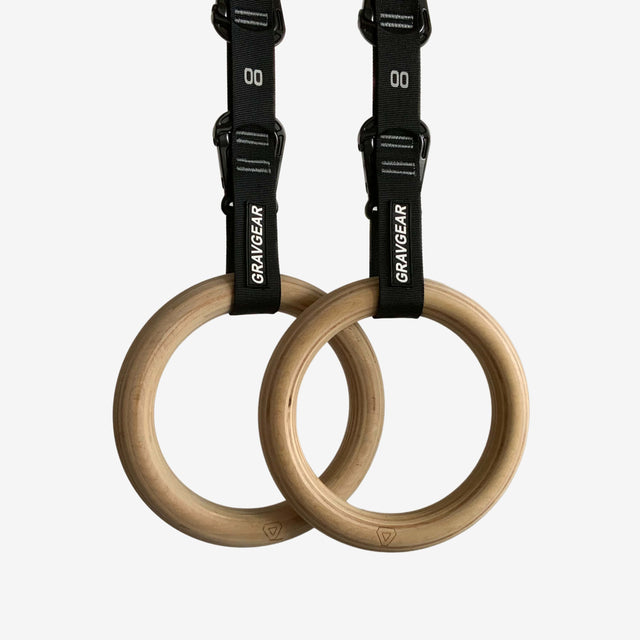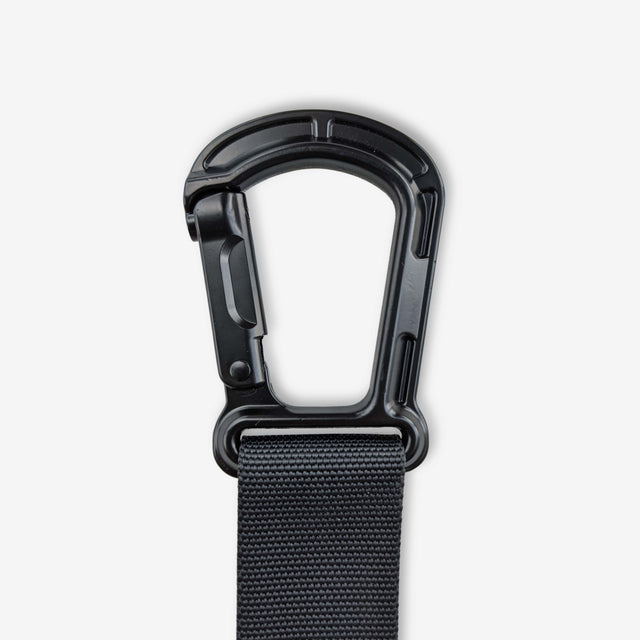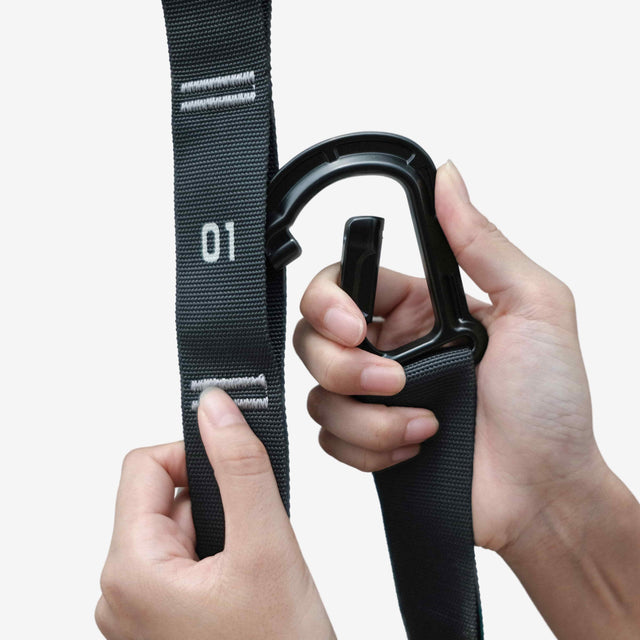7 LEG EXERCISES WITH GYMNASTIC RINGS FOR TOUGH BLOKES
Gymnastic ring leg exercises boost functional strength, stability, and mobility while enhancing skills like planches. Start with assisted squats, progress to pistols, and add weight or tempo (4-1-2-0) for hypertrophy. Train every other day, focus on form, and balance upper and lower body development.
Let’s dive into:
- 7 Leg exercises with gymnastic rings
- Beginner to advanced leg exercises with gymnastic rings workout plans
- What are leg exercises with gymnastic rings?
- Why do leg exercises with gymnastic rings?
- 4 Common mistakes and how to avoid them
- FAQs
7 Leg exercises with gymnastic rings
1️⃣ Bodyweight squats with rings
Start with assisted squats if you’re a beginner. Hold the rings to help stabilize as you descend.
Add tempo control (e.g., 4 seconds down, 1-second pause, 2 seconds up) to engage more muscle fibers.
These strengthen your quads, glutes, and balance while setting a solid foundation for advanced moves.
2️⃣ Bulgarian split squats with rings
Place your rear foot in a ring set at knee height. This setup forces a deep range of motion, making it one of the most effective leg exercises for unilateral strength.
Scale by adding weight or increasing the depth to make it even tougher.
Perfect for evening out imbalances and building explosive lower body power.
3️⃣ Pistol squats with ring assistance
Use rings for stability as you lower into the eccentric phase of the pistol squat. This helps you build the strength and balance needed to progress toward unassisted pistols.
Once you’ve mastered the movement, add weight to keep it challenging.
4️⃣ Ring-assisted shrimp squats
Focus on lowering your back knee to the floor for maximum depth. Rings assist with balance but don’t let them carry the load. This move crushes your quads, glutes, and hip flexors while sharpening your coordination.
5️⃣ Hamstring curls with rings
Slide your feet into the rings and lift your hips into a bridge.
Curl your heels toward your glutes in a slow, controlled motion.
For progression, try single-leg curls or add resistance with weight plates or bands.
This is your go-to for hamstring and glute strength without needing gym machines.
6️⃣ Reverse nordic curls
Lean backward while holding the rings for stability. This move hits your quads and hip flexors hard while improving flexibility.
A must for those looking to develop strong, mobile legs.
7️⃣ Sissy squats with rings
Use rings to stabilize as you isolate the quads in this classic move.
Focus on keeping your body straight as you bend at the knees.
These are excellent for advanced quad development or as an accessory exercise in your routine.
Beginner to advanced leg exercises with gymnastic rings workout plans
| Level | Exercise | Sets | Reps | Tempo | Rest |
| Beginner plan | |||||
| Squats with rings | 3 | 12 | 4-1-2-0 | 60 seconds | |
| Ring-assisted Bulgarian split squats | 3 per leg | 10 | 4-1-2-0 | 60 seconds | |
| Ring hamstring curls | 3 | 8-12 | 4-1-2-0 | 60 seconds | |
| Intermediate plan | |||||
| Ring-assisted pistol squats | 4 | 8-10 per leg | 4-1-2-0 | 50 seconds | |
| Shrimp squats with rings | 4 | 8 | 4-1-2-0 | 50 seconds | |
| Nordic curls | 4 | 10 | 4-1-2-0 | 50 seconds | |
| Advanced plan | |||||
| Weighted Bulgarian split squats | 5 | 8-12 | 4-1-2-0 | 40 seconds | |
| Single-leg hamstring curls | 5 | 6-8 per leg | 4-1-2-0 | 40 seconds | |
| Reverse nordic curls | 5 | 12-15 | 4-1-2-0 | 40 seconds |
Time under tension
Follow the 4-1-2-0 tempo (4 seconds lowering, 1-second hold, 2 seconds lifting, 0 pause).
Rest intervals
Beginners rest for 60 seconds, intermediates for 50 seconds, and advanced for 40 seconds.
Progression
If you can exceed the maximum reps (12) easily, switch to a harder variation or add resistance (e.g., weight vests).
Training split
Adopt a push, pull, legs weekly split with abs trained every other day. Add two ab exercises to push, pull, or leg days, and focus solely on abs on Sundays for recovery balance.
What are leg exercises with gymnastic rings?
Leg day often gets sidelined in bodyweight training, and when gymnastic rings come into the picture, it’s easy to assume they’re just for upper body work.
But here’s the truth: leg exercises with gymnastic rings unlock incredible potential for functional strength, mobility, and aesthetics
From mastering assisted pistol squats to hamstring curls, rings offer a unique, instability-driven challenge that builds power, balance, and control.
Whether you’re chasing the perfect planche or just a balanced physique, strong legs are the key.
Most people think rings are all about arm and core strength, but neglecting your lower body could limit your overall performance.
Why do leg exercises with gymnastic rings?
🧰 Functional strength
Gymnastic rings aren’t just for show-off moves. They train your legs to generate explosive strength, giving you the power to nail dismounts or tackle any sport with precision.
Plus, they demand coordination, which translates to better performance in everything from athletics to everyday life.
🧘 Stability & core engagement
The instability of rings means your hips, core, and lower body muscles are constantly firing to keep you balanced.
This is the kind of functional strength machines can’t touch. Rings humble you, but they also make you stronger in ways you didn’t expect.
💪 Progressive overload
Rings adapt to your level.
Struggling with bodyweight squats? Use the rings for assistance.
Ready to level up? Tempo changes, single-leg variations, or even adding weight turn up the intensity.
No matter where you are in your training, rings keep pushing you forward.
⚖️ Balanced physique
Let’s be real – calisthenics can leave you top-heavy. Ring leg training balances your physique, giving you strong, proportional legs that match your upper body. You’ll feel sturdier, move better, and look like a unit.
3 Benefits beyond leg strength
1 – Core activation
Gymnastic rings demand midline stability with every movement. This engages your abs and obliques, strengthening your core while improving balance and control. The added instability makes even basic exercises a test of core endurance.
2 – Improved mobility
Dynamic moves like ring-assisted sissy squats stretch and strengthen the quads and hip flexors, enhancing flexibility. This isn’t just about preventing injuries—better mobility translates to smoother performance in other exercises and daily activities.
3 – Better ring skills
Leg strength improves body tension and control, critical for advanced skills like l-sits, straddles, and handstands. Stronger legs mean less wobble and more stability, especially in transitions and holds. This carries over to almost every movement on the rings.
4 Common mistakes and how to avoid them
❌ Overloading without progression
Jumping into advanced movements too soon leads to poor form and potential injury. Start with simpler exercises like ring-assisted squats to build strength and control before advancing to harder variations like pistol squats.
❌ Neglecting time under tension
Skipping controlled tempo limits muscle engagement. Use a 4-1-2-0 tempo (four seconds lowering, one second pause, two seconds lifting, no rest at the top) for each rep. This increases intensity and ensures proper technique.
❌ Improper ring height
Incorrectly adjusted rings disrupt stability and balance. Ensure the rings are positioned at a height that allows full range of motion while keeping you in control. For example, rings at knee height are ideal for Bulgarian split squats.
❌ Ignoring recovery
Training legs too frequently leads to overtraining and diminished results. Allow at least 48 hours between leg-focused sessions to ensure proper recovery and optimal performance in subsequent workouts.
FAQs
🤔 Do leg exercises with rings build size or just strength?
Leg exercises with rings can build both strength and size, depending on how you structure your training. To focus on hypertrophy, use higher volume (8-12 reps, 4-5 sets) with controlled tempo and added resistance like weight vests or dumbbells for movements such as Bulgarian split squats or ring-assisted pistol squats.
💭 Will leg training make me heavier for gymnastics skills?
Balanced leg training enhances performance without unnecessary bulk. By focusing on functional strength and mobility, exercises like ring-assisted shrimp squats or hamstring curls improve overall body tension and control, vital for skills like planches and maltese holds, without making you sluggish.
🙋♂️ Can I substitute equipment for certain movements?
Yes, equipment like resistance bands can substitute for movements like hamstring curls when rings aren’t available. For exercises like Bulgarian split squats, adding dumbbells or a weighted backpack can increase intensity. Rings provide unmatched versatility, but smart substitutions keep the gains coming.
Conclusion
Leg exercises with rings build functional strength, enhance performance in skills like planches and handstands, and balance out the body.
Consistency and gradual progression are the keys to maximizing results and avoiding stagnation.
Keep showing up, stay disciplined, and let the gains follow.
If you found this helpful and think your workouts are going to get much better, consider this:
- Comment below with your ideas about this blog (improvements, questions, your own personal experience)
- Hop in the 3k+ member Gravgear telegram channel and get to know who we are and connect with other people like you
- Send the link to this blog to any calisthenics group chats you’re in and share the insights










0 Comments
There are no comments for this article. Be the first one to leave a message!